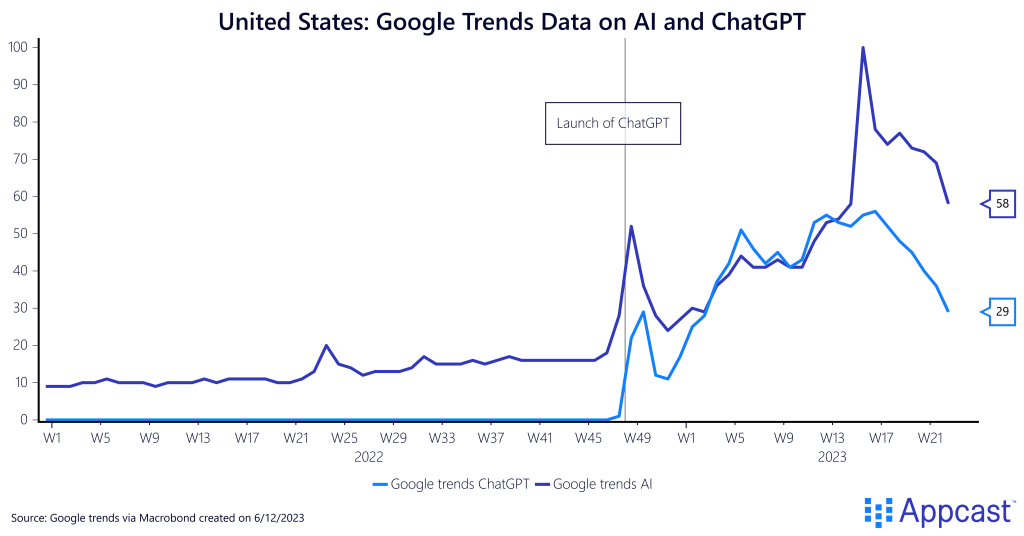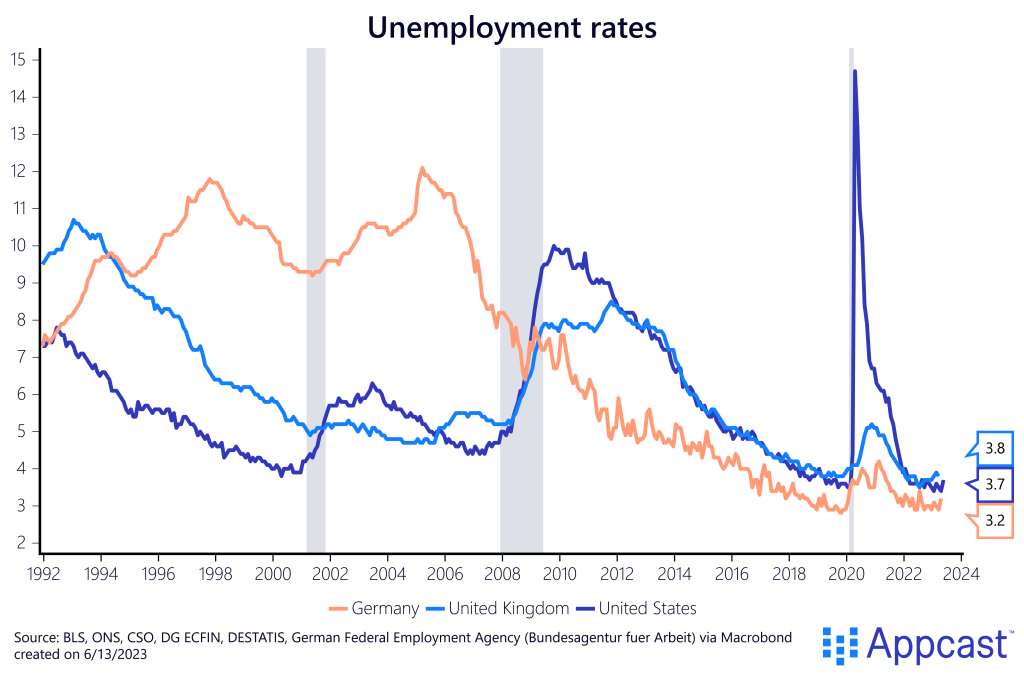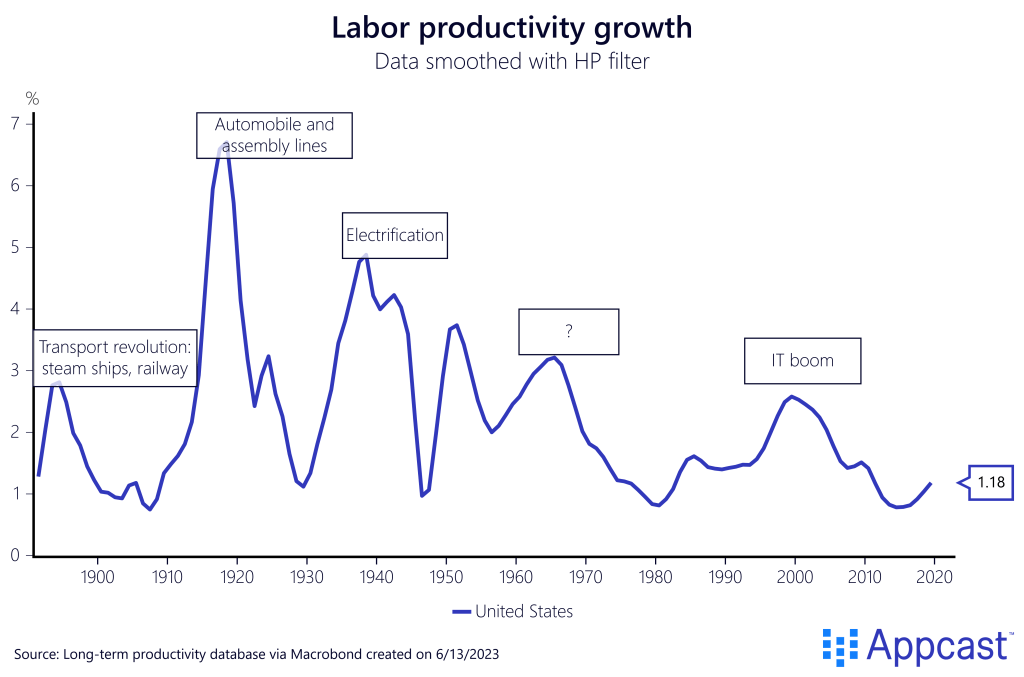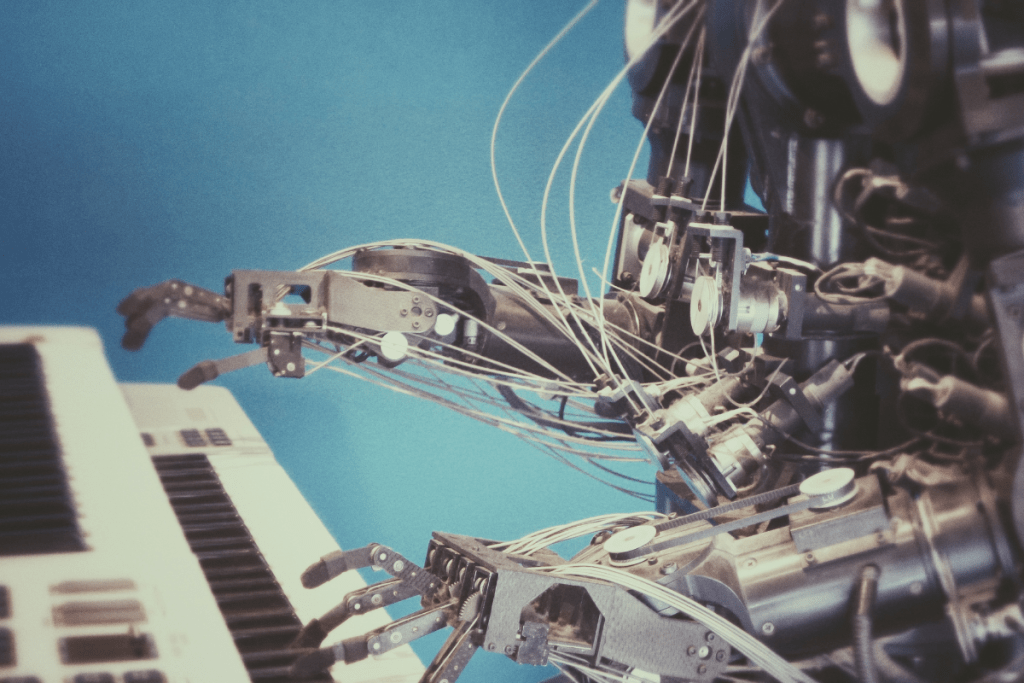Will artificial intelligence be the next big productivity booster?
Artificial intelligence and ChatGPT are all the rage right now and companies, workers, and even countries are trying to deal with a new future where rapid technological progress has become a new reality. While some companies are openly embracing ChatGPT and the productivity gains it may bring, other companies are more careful, and some have even outright banned its use.
As with past technological advancements, there are concerns about the impact of AI on employment. The technology has the potential to be transformative for the labor market. AI has the capacity to enhance productivity, reduce costs, and create new industries and job opportunities, but it could also make certain roles obsolete.
The number of job postings that mention AI have massively increased over the last year, showing the extent to which AI skills are sought after right now. Companies are desperately looking for analytical workers that have familiarized themselves with these new technologies.
Looking at Google trends data shows the extent to which artificial intelligence and ChatGPT have become trending topics since last year.

The big hope is that this new technology could be the next general purpose technology (GPT) (no relation to ChatGPT – which stands for “generative pre-trained transformer”) and that a widespread adoption across industries could be a game changer for economic growth.
Before going into the nitty-gritty of AI and ChatGPT, let’s briefly discuss some examples of GPTs throughout history. These are technologies that have the potential to significantly impact many different sectors of the economy and society and enable the creation of new products and services. GPTs are characterized by their ability to improve productivity and spur innovation across multiple industries. They have a long-term impact on the entire economy, transforming the way businesses operate and people live their lives and creating stronger long-term economic growth as a result.
Examples of GPTs include:
- The Printing Press: The printing press made it possible to mass-produce books and other printed materials, which enabled the spread of knowledge and the development of new fields of study. Economic historians believe that this technology was a prerequisite for the Industrial Revolution.
- The Steam Engine: The steam engine revolutionized transportation and manufacturing.
- Electricity: The widespread availability of electricity transformed the manufacturing sector and enabled the creation of many new products and services, such as electric lighting, appliances, and machinery.
- The Computer: The computer transformed the way people work, communicate, and access information.
- The Internet: The Internet revolutionized communication, commerce, and entertainment and enabled the creation of many new digital products and services.
So, which are the occupations and industries that will be the most affected?
One of the key questions is, of course, which industries and occupations will be the most affected by the implementation of AI and ChatGPT. Interestingly, ChatGPT itself has an opinion on this topic and provided me with a list of occupations that could be negatively affected by the implementation of AI:
- Customer Service Representatives
- Data Entry Clerks
- Telemarketers
- Assembly Line Workers
- Truck Drivers
And the jobs that according to ChatGPT could benefit the most are the following:
- Data Analysts
- Customer Service Representatives
- Healthcare Professionals
- Financial Analysts
- Manufacturing Workers
You will have noticed some overlap between the lists of industries and jobs positively and negatively affected by AI and ChatGPT. That is no coincidence!
We want this technology to improve economic growth, and the only way it can do that is by increasing productivity across the board and making certain jobs superfluous. At the same time, however, this will lead to the creation of many new jobs, even within the same industries where some of the displacement will occur.
Therefore, don’t believe all the horror stories about technological unemployment! The tech boom of the 1990s led to a brief spurt of productivity growth in advanced economies while unemployment rates declined at the same time.

Large and rapid increases in the unemployment rate are mostly due to recessions, while technology would only affect the underlying long-term structural rate of unemployment.
While job displacements are certain with rapid technological change, technological unemployment is extremely unlikely, especially as advanced economies are increasingly facing a worker shortage. Even with these new technologies, there will be a lack of labor, rather than an abundance of it.
But when will this economic transformation actually happen?
Famous Nobel prize winner and New York Times columnist Paul Krugman has been ridiculed numerous times for his 1998 statement that the internet would be no more transformative than the fax machine. Later on, he admitted that he was wrong. However, when you look at the broader productivity statistics, Krugman has been right that the internet and internet-related technologies have not been the productivity booster that many predicted they’d be.
Other than the rather short-lived tech boom, productivity growth has actually been abysmal for a long time now. Productivity growth averaged 2% in the 1960s and 1970s and again in the early 2000s. But, on average, it has been significantly lower in recent decades compared to the post-WW2 period.

That is not to say that modern technology didn’t contribute to economic growth. But research suggests that aging societies in advanced economies are having a large negative impact on long-run economic growth and all the technological advances in recent decades have not been able to make up for the negative impulses that have been coming from aging societies and inefficient housing markets, for example.
AI will boost consumer welfare before affecting productivity in a meaningful way
Many new innovations in recent decades have actually boosted consumer welfare, rather than productivity. Think about social networks like Instagram and Facebook, consider Youtube and streaming services. Think about all the apps we use on our smartphones on a daily basis. There is no doubt that consumers have benefitted enormously from these new services, but they haven’t made us more productive. In the same spirit, some AI technologies will benefit consumers first but will not have any meaningful impact on aggregate productivity statistics.
Conclusion
ChatGPT has given some interesting examples of jobs and sectors that might be vulnerable to AI, which include customer service professionals, analysts, legal clerks, etc. At the same time, concerns about technological unemployment are unwarranted. There were several hundred thousand switchboard operators in the US at the beginning of the 20th century. With the coming of the 1930s, technology that allowed telephone users simply to dial another phone without the aid of an operator had become widespread. Phone companies took advantage of the moment to slash their workforces, and thousands of operators lost their jobs. By 1940, there were fewer than 200,000 in all and that number has now gone down to just 6,000.
But are those would-be switchboard operators unemployed today? Of course not! This technological advancement allowed for workers to find new positions and restructured the workforce to do away with a mundane job to allow productivity to flourish elsewhere. Workers whose jobs have been displaced will find new occupations, especially in today’s tight labor market. Such a transition is not always be easy or smooth, but the risks of widespread technological unemployment are very much blown out of proportion.
General purpose technologies have always led to job displacements and at the same time, created lots of growth opportunities in other sectors while boosting living standards in general. The big hope is that AI can actually do the same in the years to come. However, do not expect to see a sudden surge in the productivity data this year or even next. Yes, ChatGPT users exceeded one hundred million within less than three months of launch date, but the fundamental logic is that the technology will not affect economic production right away and instead work with lags. Goldman Sachs estimates that AI could boost global productivity by about 1.5% over the next 10 years. While companies that are in the AI space have completely outperformed the market over the last year, it remains to be seen whether these valuations are actually justified. It will take time for AI to show up in the productivity statistics, so do not expect economic miracles right away!







